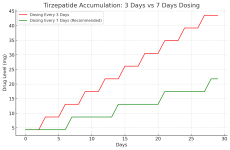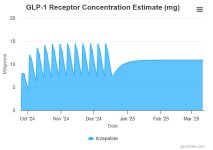Half life is a bit more complicated than that, for more straightforward drugs like testosterone, it's often optimal to dose more frequently to maintain stable blood levels.
But tirzepatide isn't really advisable to dose more frequently than every 5-7 days because of it's slow-release formulation and specific pharmacokinetics, it's designed for steady realease over a longer timespan. The half life of 5 days does not refer to the amount injected, but for how long it takes for the concentration of avtive substance in your blood stream to reduce by half.
chatgpt since im lazy:
Key Differences Between Tirzepatide and Testosterone Dosing:
- Testosterone Enanthate: Adjusting dosing schedules for testosterone works because the goal is to maintain stable hormone levels. Testosterone enanthate has a half-life of around 4-5 days, and dosing every 3 days can help maintain stable levels by reducing fluctuations. Since testosterone doesn’t rely on a slow-release mechanism beyond its basic pharmacokinetics, frequent dosing works without significant issues.
- Tirzepatide: Tirzepatide, however, is a dual GLP-1 and GIP receptor agonist with a slow-release mechanism that’s engineered for once-weekly administration. After injection, tirzepatide is slowly absorbed into your bloodstream over the course of the week. The half-life of 5 days refers to how long it takes for half of the drug already in your bloodstream to be metabolized and cleared, but due to its slow-release formulation, it continues to provide a steady effect over the entire 7-day period(
Diabetes Journals
)(
Diabetes Journals
).
Why Dosing Every 3 Days Doesn't Work:
- Drug Accumulation: If you inject tirzepatide every 3 days, the previous dose hasn't fully released and cleared from your system. This leads to overlapping doses, causing drug accumulation in your bloodstream. Instead of the steady levels intended by the weekly dosing, you end up with higher-than-needed concentrations, which can increase the risk of side effects like nausea, vomiting, and gastrointestinal issueswithout improving efficacy(
Diabetes Journals
).
- Receptor Saturation: Tirzepatide’s mechanism is different from testosterone. It works by engaging GLP-1 and GIP receptors, which regulate insulin, appetite, and metabolic processes. Dosing more frequently can lead to overstimulation of these receptors, causing more side effects without providing extra benefits. These metabolic pathways need consistent, regulated engagement, and the once-weekly dosing ensures that receptor activation is balanced(
Drugs.com
)(
Diabetes Journals
).
- Designed for Weekly Dosing: The slow-release formulation of tirzepatide is specifically designed for weekly administration to minimize peaks and troughs and allow for controlled, gradual drug absorption. By sticking to the weekly schedule, you keep the drug levels within the therapeutic range. More frequent dosing (e.g., every 3 days) disrupts this balance and can lead to accumulation of the drug beyond safe levels(
Diabetes Journals
).
Conclusion:
While it’s possible to adjust testosterone dosing schedules to maintain stable levels,
tirzepatide's slow-release mechanism and receptor-based action are designed for a specific dosing interval (once weekly).
Dosing every 3 days leads to
drug accumulation, overstimulation of receptors, and greater side effects without providing additional benefits.




